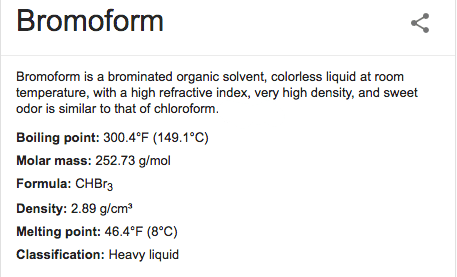About Bromoform
One of the most common sources of bromoform in the environment is seawater, where it is produced by algae and other marine organisms. However, bromoform can also be found in drinking water, particularly in areas where disinfection byproducts are formed during the water treatment process.
This has led to increased awareness of the potential health risks associated with bromoform exposure, including increased cancer risk and reproductive issues.
Despite these concerns, bromoform has been used for various industrial purposes, including as a solvent and in the production of pharmaceuticals and pesticides. However, the potential health risks associated with bromoform exposure have led to increased regulation and restrictions on its use in many countries around the world.
In this blog post, we’ll take a closer look at bromoform and its potential health risks, as well as its various industrial and environmental uses. We’ll also discuss the regulations and restrictions on bromoform use, and the ongoing efforts to find safer alternatives.
What is Bromoform?
IUPAC Standard InChI: InChI=1S/CHBr3/c2-1(3)4/h1
Bromoform is one of the four haloforms (chemically active metals). The substance is a colorless to yellow liquid with a sweet, chloroform-like odor. It is an organic, non-flammable solvent with a high density and can be made using the haloform reaction.
What is the Bromoform Formula?
Bromoform, also known as tribromomethane, is a colorless to yellowish liquid with a sweet odor. Its chemical formula is CHBr3, which means it contains one carbon atom, three bromine atoms, and one hydrogen atom. Bromoform is a member of the group of volatile organic compounds (VOCs) that can be found in both natural and industrial environments.
What Types of Industrial Uses Does it Have?
The principal use of bromoform is as a laboratory reagent. The substance is also an essential ingredient for making solvent, flame retardant, and sedative in the past. Aside from its use in laboratories, bromoform is also used in geological and electronics testing.
Bromoform has many uses in industry, including as a solvent for waxes, oils, and resins, as well as a flame retardant in plastics and textiles. However, it is also considered a hazardous material because it can be toxic to humans and the environment.
To measure the level of bromoform in a substance, scientists use the unit of mg kg, which means milligrams of bromoform per kilogram of the substance being tested. This is important because exposure to even small amounts of bromoform can have negative effects on human health, including liver and kidney damage, as well as neurological problems.
Bromoform is also a chemically active substance and can react with certain metals, such as aluminum and zinc, to form potentially explosive compounds. This is why it is important to handle bromoform with care and to follow proper safety procedures when working with it.
How Does Bromoform Get into Your Drinking Water?
Since bromoform is a disinfection byproduct, it contaminates drinking water when chlorine is added to water systems. It is a residue of the process of chlorination in most municipal water systems in the United States and in almost all parts of the world.
What are the Health Risks Associated with Bromoform?
Long-term or short-term exposure to bromoform in chlorinated drinking water may result in different types of health problems. An individual who consumed levels of bromoform above the EPA’s contamination level standards may experience damages to their central nervous system, liver, and kidney.
It is considered a known or suspected carcinogen, which means it has the potential to cause cancer. Exposure to bromoform can occur through inhalation, ingestion, or contact with affected skin areas.
Furthermore, if there is a fire involving tanks containing bromoform, highly toxic fumes can be produced, which can lead to serious respiratory problems or even death. Ingestion of bromoform can also cause nausea, vomiting, abdominal pain, and central nervous system depression.
It is crucial to take immediate action if exposure to bromoform occurs. If ingested, medical professionals may induce vomiting highly to prevent further absorption. If inhaled or exposed to affected skin areas, it is recommended to move to fresh air and seek medical attention immediately.
Workers Exposed to Bromoform
Employers should provide proper respiratory protection and protective clothing for anyone working around bromoform. Workers should try to prevent skin contact. If contaminated, a worker should wash skin that’s been exposed. It is important to immediately flood affected skin to prevent skin absorption.
Bromoform is irritating to skin, eyes, and respiratory tract. If inhaled, it’s recommended that a self contained breathing apparatus be used and to take deep breaths of fresh air. If it gets in eyes, it’s important to remove contact lenses and contact the poison control center.
Bromoform gives off irritating or toxic fumes in a fire and is considered a fire hazard since it does produce toxic gases.
How Common is Bromoform in Water?
Bromoform is common in many water systems since it is a byproduct of chlorination.
What is the EPA’s Contamination Level Standards for Bromoform in Drinking Water?
EPA has set an MCLG of zero for bromoform and an MCL of 0.080 mg/L or 80 ppb.
What is the Best Reduction Media for Removing Bromoform from Drinking Water?
Since it is a common drinking water contaminant found in tap water due to the adding of chlorine to water systems, most of the water filter systems today are designed to catch the chemical compound to protect the public from its health effects.
An AquaOx filter system is built with a multi-stage filtration with granular activated carbon to eliminate bromoform and other chemicals in tap water. Prevent health problems tomorrow by installing a reliable water filtration system today!
From The Agency of Toxic Substances and Disease Registry
CAS#: 75-25-2; 124-48-1
Bromoform (also known as tribromomethane) and dibromochloromethane are colorless to yellow, heavy, nonburnable liquids with a sweetish odor. These chemicals are possible contaminants of drinking water that has been chlorinated to kill bacteria and viruses that could cause serious waterborne infectious diseases.
Bromoform and dibromochloromethane may form when chlorine reacts with other naturally occurring substances in water, such as decomposing plant material. Plants in the ocean also produce small amounts of these chemicals.
These chemicals are found mainly in water that originally came from surface sources, such as rivers and lakes. Springs and deep drilled wells usually contain very little of the substances that react with chlorine to form these chemicals; therefore, well and spring water is less likely a source of bromoform and dibromochloromethane than water from a reservoir (artificial lake).
The amount of bromoform and dibromochloromethane in drinking water can change considerably from day to day, depending on the source, temperature, amount of plant material in the water, amount of chlorine added, and a variety of other factors.
In the past, the colorless liquid was used by industry to dissolve dirt and grease and to make other chemicals. Bromoform was also used in the early part of this century as a medicine to help children with whooping cough get to sleep.
Currently, bromoform is only produced in small amounts for use in laboratories and in geological and electronics testing. Dibromochloromethane was used in the past to make other chemicals such as fire extinguisher fluids, spray can propellants, refrigerator fluid, and pesticides. It is now only used on a small scale in laboratories.
In the environment, bromoform and dibromochloromethane are not found as pure liquids, but instead, they are found either dissolved in water or evaporated into air as a gas. The vapor pressure for bromoform is 5 mmHg at 68°F ; 5.6 mmHg at 77°F.
Both bromoform and dibromochloromethane are relatively stable in the air, but reactions with other chemicals in the air cause them to break down slowly (about 50% in 1 or 2 months). Bromoform and dibromochloromethane in water or soil may also be broken down by bacteria, but the speed of this process is not known.
Need a water filter that will remove this? Checkout our whole house water filters.







